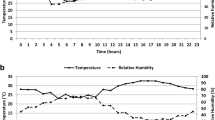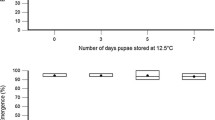Abstract
The Sterile Insect Technique (SIT) is currently being investigated against Aedes albopictus Skuse (Diptera: Culicidae) mosquitoes in Panchvati, a village in Mauritius. As an essential step before field releases, this study investigated the effect of temperature (2 h exposure at 5, 10, 15 or 25 °C) and compaction (2000 males per 1062 or 8553 cm3) on the fitness of radio-sterilised Ae. albopictus males with the aim of optimising their transport from the mosquito-production unit to the release site in Panchvati. Temperature and compaction had no significant effect on male survival during the first fifteen days. However, when survival was assessed over twenty-five days, males stored at 25 °C had significantly higher survival rates than males stored at lower temperatures (Kaplan-Meier: P < 0.05). Furthermore, males stored at 5 °C survived significantly longer than those stored at 10 °C or 15 °C (Kaplan-Meier: P < 0.05). Considering the fact that a weekly release of sterile males is planned in Panchvati, the long-term negative effect of low temperatures (5 to 15 °C) on male survival, may have limited relevance in the field. Male storage at 5 °C for 2 h in compacted conditions, were hence further investigated. Compaction significantly impacted male competitiveness, with a mean competitiveness index of 0.2 when sterile males were stored at 2000 males per 1062 cm3. Two thousand males per Bugdorm cage (27,000 cm3), was found to be the optimal density at which sterile Ae. albopictus males could be stored and transported by van to Panchvati, with minimal effects of the latter’s survival and competitiveness.



Similar content being viewed by others
References
Alto BW, Bettinardi D (2013) Temperature and dengue virus infection in mosquitoes: independent effects on the immature and adult stages. Am J Trop Med Hyg 88:497–505
Aluja M, Rull J, Pérez-Staples D, Díaz-Fleischer F, Sivinski J (2009) Random mating among Anastrepha ludens (Diptera: Tephritidae) adults of geographically distant and ecologically distinct populations in Mexico. Bull Entomol Res 99:207–214
Balestrino F, Medici A, Candini G, Carrieri M, Maccagnani B, Calvitti M, Maini S, Bellini R (2010) γ ray dosimetry and mating capacity studies in the laboratory on Aedes albopictus males. J Med Entomol 47:581–591
Balestrino F, Puggioli A, Gilles JR, Bellini R (2014) Validation of a new larval rearing unit for Aedes albopictus (Diptera: Culicidae) mass rearing. PLoS One 9:e91914
Bayoh MN (2001) Studies on the development and survival of Anopheles gambiae sensu stricto at various temperatures and relative humidities. Thesis (PhD), Durham University. http://etheses.dur.ac.uk/4952/. Accessed 11 Nov 2018
Bellini R, Puggioli A, Balestrino F, Brunelli P, Medici A, Urbanelli S, Carrieri M (2014) Sugar administration to newly emerged Aedes albopictus males increases their survival probability and mating performance. Acta Trop 132:S116–S123
Bowle K (1987) Cellular heat injury. Are membranes involved? In: Bowler K, Fuller BJ (eds) Temperature and animal cells. Society of Experimental Biology Symposium, Cambridge, pp 157–185
Brady OJ, Johansson MA, Guerra CA, Bhatt S, Golding N, Pigott DM, Delatte H, Grech MG, Leisnham PT, Maciel-De-Freitas R, Styer LM (2013) Modelling adult Aedes aegypti and Aedes albopictus survival at different temperatures in laboratory and field settings. Parasit Vectors 6:351
Christophers S (1960) Aedes aegypti (L.) the yellow fever mosquito: its life history, Bionomics and Structure. The Syndics of the Cambridge University Press, Bentley House, London. pp 739
Chung HN, Rodriguez SD, Gonzales KK, Vulcan J, Cordova JJ, Mitra S, Adams CG, Moses-Gonzales N, Tam N, Cluck JW, Attardo GM (2018) Toward implementation of mosquito sterile insect technique: the effect of storage conditions on survival of male Aedes aegypti mosquitoes (Diptera: Culicidae) during transport. Int J Insect Sci 18:1–7
Culbert NJ, Lees RS, Vreysen MJ, Darby AC, Gilles JR (2017) Optimised conditions for handling and transport of male Anopheles arabiensis: effects of low temperature, compaction, and ventilation on male quality. Entomol Exp Appl 164:276–283
Culbert NJ, Balestrino F, Dor A, Herranz GS, Yamada H, Wallner T, Bouyer J (2018) A rapid quality control test to foster the development of genetic control in mosquitoes. Sci Rep 8:16179–16188
Damiens D, Tjeck PO, Lebon C, Le Goff G, Gouagna LC (2016) The effects of age at first mating and release ratios on the mating competitiveness of gamma-sterilised Aedes albopictus males under semi field conditions. Vector Biol J 1:29–31
Delatte H, Gimonneau G, Triboire A, Fontenille D (2009) Influence of temperature on immature development, survival, longevity, fecundity, and gonotrophic cycles of Aedes albopictus, vector of chikungunya and dengue in the Indian Ocean. J Med Entomol 46:33–41
Enkerlin W (2007) Guidance for packing, shipping, holding and release of sterile flies in area-wide fruit fly control programmes (no. 190). Food & Agriculture Organization, Rome, p 31
Enkerlin W, Gutiérrez-Ruelas JM, Cortes AV, Roldan EC, Midgarden D, Lira E, López JLZ, Hendrichs J, Liedo P, Arriaga FJT (2015) Area freedom in Mexico from Mediterranean fruit fly (Diptera: Tephritidae): a review of over 30 years of a successful containment program using an integrated area-wide SIT approach. Fla Entomol 98:665–681
Fried M (1971) Determination of sterile-insect competitiveness. J Econ Entomol 64:869–872
Gerberg EJ (1970) Manual for mosquito rearing and experimental techniques. AMCA 5:72–73
Gubler DJ, Bhattacharya NC (1971) Observations on the reproductive history of Aedes (Stegomyia) albopictus in the laboratory. Mosq News 31:356–359
Helinski ME, Mo'awia MH, El-Motasim WM, Malcolm CA, Knols BG, El-Sayed B (2008) Towards a sterile insect technique field release of Anopheles arabiensis mosquitoes in Sudan: irradiation, transportation, and field cage experimentation. Malar J 7:65
Hepburn HR (1985) Structure of the integument. Comprehensive Insect Physiology, Biochemistry and Pharmacology 3:1–58
Hernández E, Escobar A, Bravo B, Montoya P (2010) Chilled packing systems for fruit flies (Diptera: Tephritidae) in the sterile insect technique. Neotrop Entomol 3:601–607
Herrero RA, Gilles JRL, Lees R (2015) Male mosquito trapping methods. Report of a technical meeting held in Vienna. 16-20 February 2015, International Atomic Energy Agency, Austria
Iyaloo DP, Oliva C, Facknath S and Bheecarry A (2019) A field cage study of the optimal age for release of radio-sterilized Aedes albopictus mosquitoes in a sterile insect technique programme. Entomol Exp Appl. In press
Liedo P, Salgado S, Oropeza A, Toledo J (2007) Improving mating performance of mass-reared sterile Mediterranean fruit flies (Diptera: Tephritidae) through changes in adult holding conditions: demography and mating competitiveness. Fla Entomol 90:33–40
Löwenberg Neto P, Navarro-Silva MA (2004) Development, longevity, gonotrophic cycle and oviposition of Aedes albopictus Skuse (Diptera: Culicidae) under cyclic temperatures. Neotrop Entomol 33:29–33
Madakacherry O, Lees RS, Gilles JRL (2014) Aedes albopictus (Skuse) males in laboratory and semi-field cages: release ratios and mating competitiveness. Acta Trop 132:S124–S129
Mortenson EW (1950) The use of sodium hypochlorite to study Aedes nigromaculis (Ludow) embryos (Diptera: Culicidae). Mosq News 10:211–212
Mubarqui RL, Perez RC, Kladt RA, Lopez JLZ, Parker A, Seck MT, Sall B, Bouyer J (2014) The smart aerial release machine, a universal system for applying the sterile insect technique. PLoS One 9:e103077
Neven LG, Hansen LD (2010) Effects of temperature and controlled atmospheres on codling moth metabolism. Ann Entomol Soc Am 103:418–423
Oliva CF, Jacquet M, Gilles JRL, Lempérière G, Maquart PO, Quilici S, Schooneman F, Vreysen MJB, Boyer S (2012) The sterile insect technique for controlling populations of Aedes albopictus (Diptera: Culicidae) on Reunion Island: mating vigour of sterilized males. PLoS One 7:e49414
Oliva CF, Maier MJ, Gilles J, Jacquet M, Lemperiere G, Quilici S, Vreysen MJ, Schooneman F, Chadee DD, Boyer S (2013) Effects of irradiation, presence of females, and sugar supply on the longevity of sterile males Aedes albopictus (Skuse) under semi-field conditions on Reunion Island. Acta Trop 125:287–293
Raminani LN, Cupp EW (1975) Early embryology of Aedes aegypti (L.) (Diptera: Culicidae). Int J Insect Morphol Embryol 4:517–528
Raminani LN, Cupp EW (1978) Embryology of Aedes aegypti (L.) (Diptera: Culicidae): organogenesis. Int J Insect Morphol Embryol 7:273–296
Rezende GL, Martins AJ, Gentile C, Farnesi LC, Pelajo-Machado M, Peixoto AA, Valle D (2008) Embryonic desiccation resistance in Aedes aegypti: presumptive role of the chitinized serosal cuticle. BMC Dev Biol 8:82
Rosay B (1959) Gross external morphology of embryos of Culex tarsalis Coquillett (Diptera: Culicidae). Ann Entomol Soc Am 52:481–484
Trpis M (1970) A new bleaching and decalcifying method for general use in zoology. Can J Zool 48:892–893
Tween G, Rendón P (2007) Current advances in the use of cryogenics and aerial navigation technologies for sterile insect delivery systems, pp 229–238. In: Area-Wide Control of Insect Pests. Dordrecht, Springer
Villaseñor A, Carrillo J, Zavala J, Stewart J, Lira C and Reyes J (2000) Current progress in the medfly program Mexico-Guatemala, pp. 361–368. In: Area-wide control of fruit flies and other insect pests. Joint proceedings of the international conference on area-wide control of insect pests, 28 May-2 June 1998 and the Fifth International Symposium on Fruit Flies of Economic Importance, Penang, Malaysia, 1–5 June 1998. Penerbit Universiti Sains, Malaysia
Vreysen MJ, Saleh K, Mramba F, Parker A, Feldmann U, Dyck VA, Msangi A, Bouyer J (2014) Sterile insects to enhance agricultural development: the case of sustainable tsetse eradication on Unguja Island, Zanzibar, using an area-wide integrated pest management approach. PLoS Negl Trop Dis 8:e2857
Yamada H, Parker AG, Oliva CF, Balestrino F, Gilles JRL (2014) X-ray-induced sterility in Aedes albopictus (Diptera: Culicidae) and male longevity following irradiation. J Med Entomol 51:811–816
Yue-Jin LZWZ, Ya-Zhao YANG (1985) Population dynamics of Aedes (stegomyia) albopictus (skuse) under laboratory conditions. Acta Entomol Sinica 3:5
Acknowledgements
This study is part of a PhD thesis sponsored by the International Atomic Energy Agency (IAEA) under MAR 5019 and Coordinated Research Programme D44002. The authors are also thankful to the Ministry of Health and Quality of Life, Mauritius for providing transport and infrastructural logistics to carry out this research and to staffs of the Vector Biology and Control Division for their participation in the transport, collection and maintenance of mosquitoes.
Author information
Authors and Affiliations
Corresponding author
Ethics declarations
The authors declare that they have no conflict of interest.
Additional information
Publisher’s note
Springer Nature remains neutral with regard to jurisdictional claims in published maps and institutional affiliations.
Electronic supplementary material
ESM 1
(XLSX 79 kb)
Rights and permissions
About this article
Cite this article
Iyaloo, D.P., Facknath, S. & Bheecarry, A. Investigating the effects of low temperature and compaction on the quality of adult radio-sterilised Aedes albopictus (Diptera: Culicidae) males in view of their optimal transport to the pilot sterile release site in Mauritius. Int J Trop Insect Sci 40, 53–62 (2020). https://doi.org/10.1007/s42690-019-00050-5
Received:
Accepted:
Published:
Issue Date:
DOI: https://doi.org/10.1007/s42690-019-00050-5




